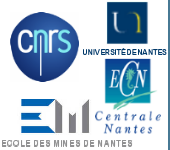Estimating fat, paste and gas in a proving puff pastry by MRI - Method and simulation results
Résumé
This paper presents a method to characterize the development of the structures of puff pastries during proving using MRI. Since the resolution is large, each pixel contains an unknown proportion of three components: fat, paste and gas. The signal to noise ratio is low since gas which reaches 80% at the end of proving gives no signal. The signal is the sum of reference signals, corresponding to pixels filled with one component, weighted by the proportions. The reference signals were supposed to be known. We adopted an edge-preserving approach based on the minimization of a penalized least-square criterion. This criterion is the weighted sum of a term accounting for the fidelity to data and a regularization term. The minimization of the criterion is based on a non-linear conjugate gradient algorithm. The settings of the weights of the two terms is based on simulations. Then simulation results are presented. The mean error was similar with or without regularization and depended on the components and their proportion (less that 1% up to 6%). Fat and gas proportions were overestimated, paste proportion was underestimated. The dispersion of the results was lower with regularization (from 0.3% up to 1.5 %). Monte-Carlo simulations showed that these results were not influenced very much by the uncertainty on the reference signals at the end of the proving. Larger uncertainties were found at the beginning of proving. We showed that the regularization of the solutions did improve the visualization of the structures confirming the interest of this approach.
| Origine | Fichiers produits par l'(les) auteur(s) |
|---|


